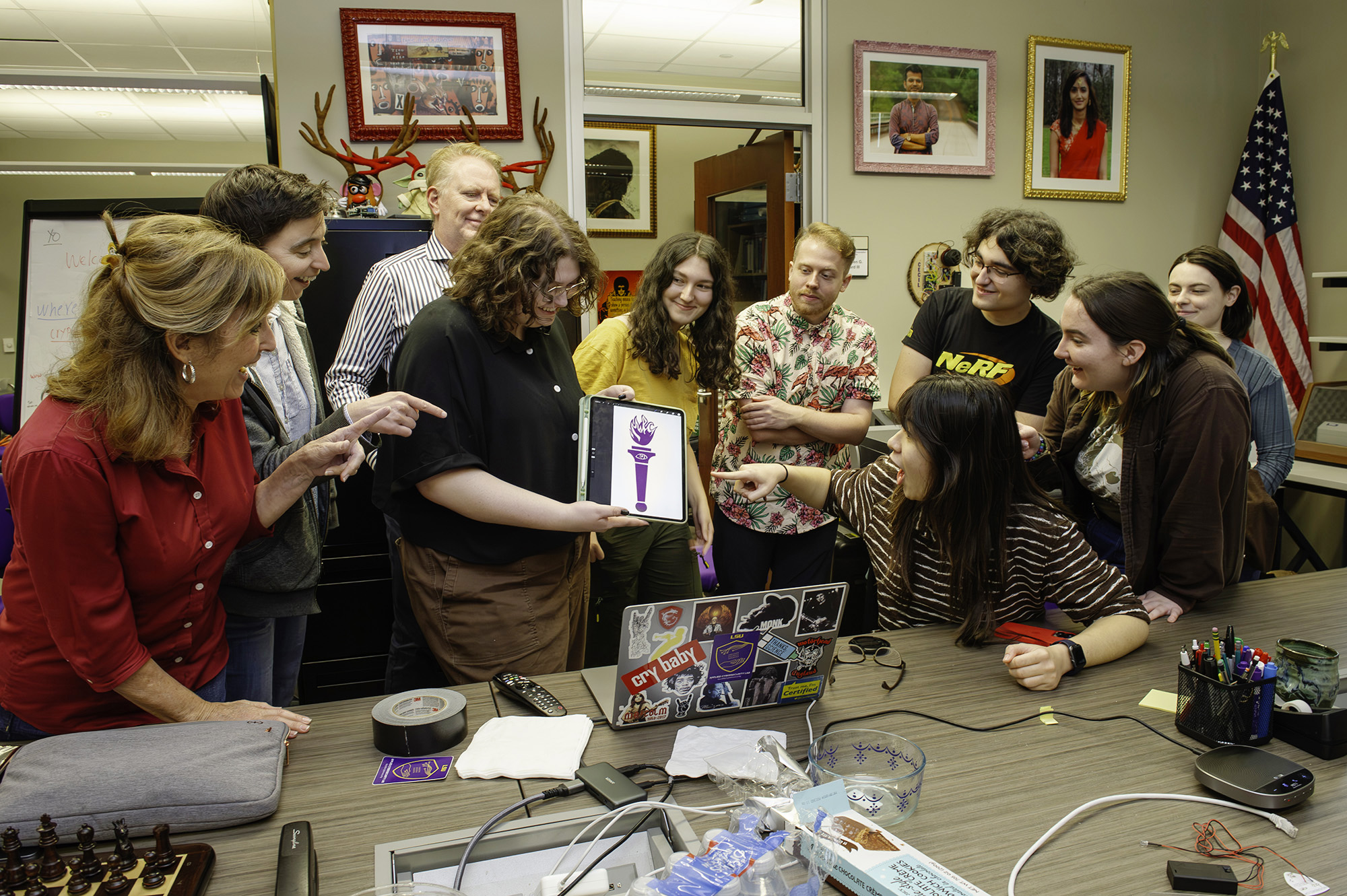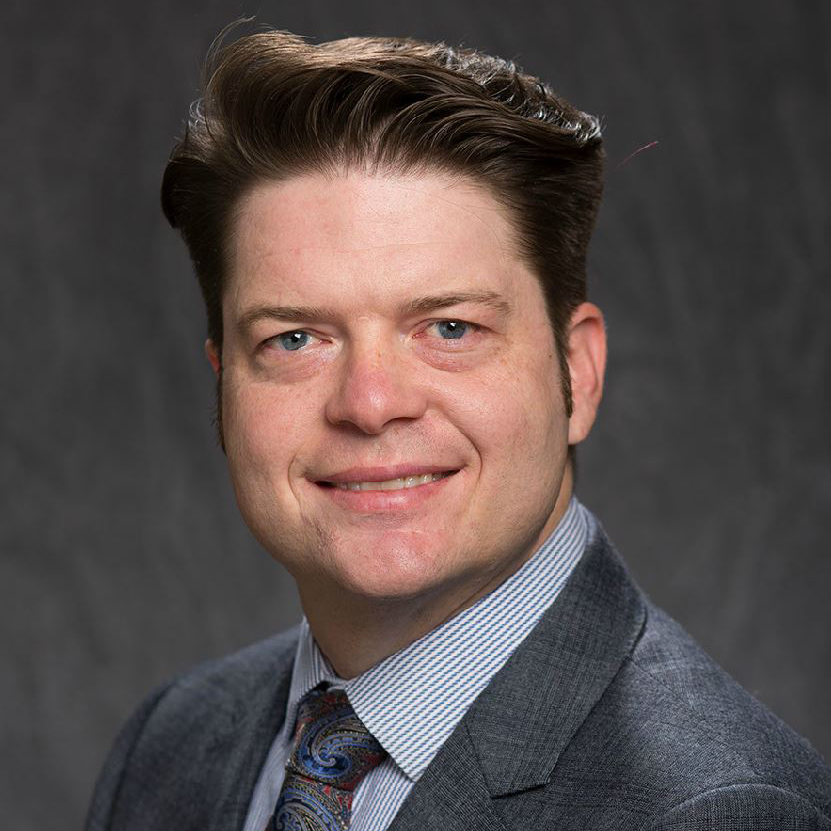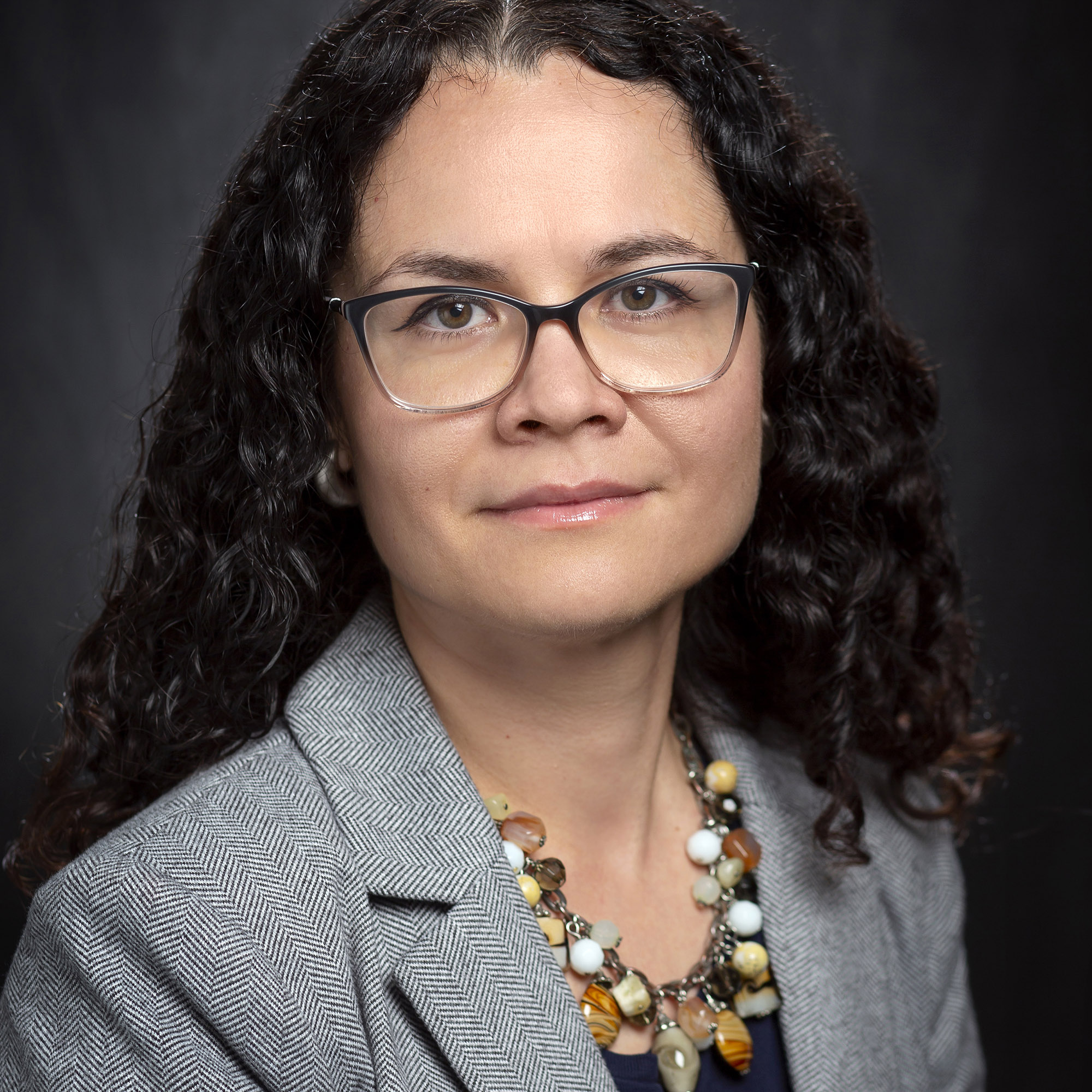Cloaked in Obviousness: How the New LSU Mystery Project Collaborative Is Drawing a Crowd
November 10, 2023

“Mysterians” gathered in the LSU Applied Cybersecurity Lab to learn about symbols used in ancient times and throughout human history, and plan the design and fabrication of high-tech amulets that light up or change color when participants meet in person. From left to right: Professor Michelle Zerba, English; Associate Professor Chris Barrett, English; Professor Golden Richard, Computer Science; Isabella Spano, majoring in the classics; Emma Hulse, also majoring in the classics; Clinton Walker, doctoral student in cybersecurity; Kaitlyn Smith, student at Baton Rouge Magnet High School and member of the LSU Applied Cybersecurity Lab; Steven Seiden, cybersecurity senior; Maddie Jackson, majoring in English and the classics; and Karley Waguespack, doctoral student in cybersecurity.
– Photo by Elsa Hahne/LSU
While people’s fascination with mystery drives research and the human quest for knowledge, few researchers study mystery itself as a shared thread across academic disciplines.
Enter Michelle Zerba and Chris Barrett, both professors in the LSU Department of English. They’re spearheading LSU’s Mystery Project Collaborative with $10,000 in support from the LSU Provost Fund for Innovation in Research, and eagerly ask:
“What’s the most mysterious thing in your life?” Barrett said. “That question is a great conversation starter.”
From mystery cults in the Mediterranean Bronze Age, to cognitive neuroscience and artificial intelligence, the Mystery Project Collaborative seeks to explore, from multidisciplinary perspectives, how mystery motivates humans into action and discovery. More than 100 LSU faculty, staff and students from across the university are already actively participating in the project, and it’s clear why.
What’s the most mysterious thing in your life? That question is a great conversation starter.
Chris Barrett, associate professor, LSU Department of English
“You quickly go to the heart of what it is we know about mystery, which is that it entices; it’s alluring,” Zerba said. “Think about the way mystery is used in marketing. You can sell the mysteries of romance, travel and the quantum universe, with its dark matter and dark energy.”
Zerba, an expert in the classics and on themes that persist from antiquity to modernity, is working on a book, called Lightning in the Soul: Mystery, Secrecy, and the Occult in the Afterlives of the Ancient Mystery Cults. Meanwhile, Barrett, a scholar of early modern English literature, is writing a book about obviousness—the opposite of mystery—and the way it negates curiosity. Her book is called The Forest for the Trees: Ecopoetics of the Obvious.
“What does it mean to say something’s obvious?” asked Barrett, hinting at a common cue of ‘don’t bother’ or ‘just don’t go there.’ “But obviousness and mystery, or secrecy, kind of exist on the same continuum. They’re all ways of saying: this is something beyond interpretation, something it is hard to talk about.”
There’s a reason why mystery is a grand genre of literature and such a consistent bestseller, Barrett argues.
“You look at the New York Times list; people flock to mystery,” Barrett said. “And there’s a reason why we’re sort of drawn to people with mystique, which is a kind of leveraging of mystery for personal appeal.”
Zerba describes mystery as the tipping point between the known and unknown.
“Mystery is in this contrary state of knowing and not knowing, and also has a wide range of emotions attached,” she said. “Sometimes fear, sometimes curiosity. And the lure is the sense of needing to bring the unknown into the light of the known.”
“When you think about it, any intellectual or academic discipline is about finding out something that has not been known before,” Barrett added. “Which is to say the entire project of engaging in research or discovery or exploration is about unraveling mystery.”
This fall, Barrett and Zerba are coordinating a listening and learning tour with reading groups across the LSU flagship campus, engaging faculty from the School of Music to the College of Engineering to lead conversations about the status of mystery in their own areas of work. Each conversation leader shares their own perspectives on mystery in discussion with a diverse internal audience. Mystery, the researchers agree, is a topic that brings scientists, humanists and artists together.
“To the traditional scholar, who admires logic and reason and whose whole profession is built on a foundation of enlightenment aspiration, the enduring nature of irrationality in an age of reason can seem disoriented and frustrating,” said Joseph Givens, faculty in the LSU College of Art & Design and director of the LSU McNair Scholars Program, who leads one of the mystery reading groups. “As I have explored the workings of mystery in the context of modern and contemporary art, I have discovered art movements that have been overlooked in the traditional art historical canon and it opened my mind to consider cultural contexts and philosophical underpinnings that were beyond what I have known. This experience has made me a more empathetic scholar and a more culturally competent person.”
Givens has come to understand the traditional narrative of modernity as an “aspirational myth,” rather than an accurate account of history.
“One need only review today’s headlines to confirm that the contemporary concerns of war, civil rights and even outer space are often interpreted by the public through the lens of irrational thought,” Givens said. “In the Surrealist Manifesto, surrealist founder André Breton proposed surrealism as a way to express ‘the actual functioning of thought… in the absence of control exercised by reason.’ To Breton, this was a hope that a new, authentic reason could reign, and to me, the Mystery Project Collaborative is an amazing opportunity to have these conversations in a framework that traverses areas of study and levels of education. It is one of the most exciting experiences of my academic career.”

Joseph Givens, faculty in the LSU College of Art & Design and director of the LSU McNair Scholars Program, says participation in the LSU Mystery Project Collaborative has been “one of the most exciting experiences of my academic career” and made him “a more empathetic scholar and a more culturally competent person” as he examines irrationality in the age of reason in art from fresh perspectives.

Inessa Bazayev, professor of music theory in the LSU School of Music and faculty senate president, says the LSU Mystery Project Collaborative has challenged her to communicate hidden meanings in music to broader audiences, “which was exciting and deeply satisfying.”
Inessa Bazayev, professor of music theory in the LSU School of Music and faculty senate president, whose reading group focused on the music of Russian composer Alexander Scriabin, agreed.
“The Mystery Project Collaborative at LSU has inspired us to reexamine and shed new light on our respective fields of study,” Bazayev said. “Scriabin’s music, for example, was driven by his so-called ‘mystic chord,’ resulting in music that aimed to serve as an intense religious experience—almost like a musical Armageddon.”
“Working with the Mystery Collaborative allowed me to revisit this aspect of his music
and connect it with broader concepts in theosophy, religion and mystery,” Bazayev
continued. “Rethinking Scriabin’s music challenged me to communicate his music and
its profound meaning to a much broader audience—something I rarely do in my discipline,
which was exciting and deeply satisfying.”
Beyond art and music, mystery also struck a chord—or code—in the Applied Cybersecurity
Lab in the LSU Center for Computation & Technology, led by Golden Richard, interim
director of the LSU Cyber Center and professor in the LSU College of Engineering.
“It’s important to remember, as we’re immersed in cybersecurity, that for the average person, it can be truly indistinguishable from magic for them,” Richard said. “Highly technical cybersecurity can be completely bewildering to the average computer user, so understanding how people deal with mysterious situations can ground us, as scientists, to help them navigate security concerns, since cybersecurity also connects with societal, behavioral and legal aspects.”
Computer science and cybersecurity students also need to be trained to “expect the mysterious,” Richard argues.
“In cybersecurity, the most obvious answer is rarely the correct answer,” he said. “Cyberattacks are stealthy and invisible, and in defending against them, we have to consider all options and treat things as mystery without jumping to conclusions until the full situation is understood. So, the Mystery Project Collaborative is helping to formalize something we do. We just weren’t calling it ‘the mystery effect.’”
Barrett and Zerba have two upcoming projects. For 2024, they are planning a speaker series featuring high-profile thinkers and artists drawn from the fields of visual art, film, cryptography, quantum theory and comparative religion. From there, they will turn to organizing an international symposium on mystery and secrecy. Ultimately, their goal is to establish a first-in-the-world Mystery Studies Institute at LSU, which would support an integrated curriculum, ongoing research projects, publications, conferences and other mystery-oriented events for “mysterians” world-wide.
Also, there has been talk of amulets.


